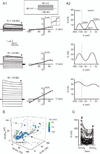Voltage-dependent K+ currents contribute to heterogeneity of olfactory ensheathing cells
- PMID: 25856239
- PMCID: PMC4506201
- DOI: 10.1002/glia.22834
Voltage-dependent K+ currents contribute to heterogeneity of olfactory ensheathing cells
Abstract
The olfactory nerve is permissive for axon growth throughout life. This has been attributed in part to the olfactory ensheathing glial cells that encompass the olfactory sensory neuron fascicles. Olfactory ensheathing cells (OECs) also promote axon growth in vitro and when transplanted in vivo to sites of injury. The mechanisms involved remain largely unidentified owing in part to the limited knowledge of the physiological properties of ensheathing cells. Glial cells rely for many functions on the properties of the potassium channels expressed; however, those expressed in ensheathing cells are unknown. Here we show that OECs express voltage-dependent potassium currents compatible with inward rectifier (Kir ) and delayed rectifier (KDR ) channels. Together with gap junction coupling, these contribute to the heterogeneity of membrane properties observed in OECs. The relevance of K(+) currents expressed by ensheathing cells is discussed in relation to plasticity of the olfactory nerve.
Keywords: ensheathing glia; gap junctions; potassium conductance.
© 2015 Wiley Periodicals, Inc.
Figures








Similar articles
-
Selective Cre-mediated gene deletion identifies connexin 43 as the main connexin channel supporting olfactory ensheathing cell networks.J Comp Neurol. 2019 May 1;527(7):1278-1289. doi: 10.1002/cne.24628. Epub 2019 Jan 21. J Comp Neurol. 2019. PMID: 30628061 Free PMC article.
-
Olfactory ensheathing cell membrane properties are shaped by connectivity.Glia. 2010 Apr 15;58(6):665-78. doi: 10.1002/glia.20953. Glia. 2010. PMID: 19998494 Free PMC article.
-
Differing phagocytic capacities of accessory and main olfactory ensheathing cells and the implication for olfactory glia transplantation therapies.Mol Cell Neurosci. 2015 Mar;65:92-101. doi: 10.1016/j.mcn.2015.03.005. Epub 2015 Mar 6. Mol Cell Neurosci. 2015. PMID: 25752729
-
Defining the role of olfactory ensheathing cells in facilitating axon remyelination following damage to the spinal cord.FASEB J. 2005 May;19(7):694-703. doi: 10.1096/fj.04-2833rev. FASEB J. 2005. PMID: 15857884 Review.
-
Understanding the neural repair-promoting properties of olfactory ensheathing cells.Exp Neurol. 2014 Nov;261:594-609. doi: 10.1016/j.expneurol.2014.05.007. Epub 2014 May 17. Exp Neurol. 2014. PMID: 24842489 Review.
Cited by
-
Selective Cre-mediated gene deletion identifies connexin 43 as the main connexin channel supporting olfactory ensheathing cell networks.J Comp Neurol. 2019 May 1;527(7):1278-1289. doi: 10.1002/cne.24628. Epub 2019 Jan 21. J Comp Neurol. 2019. PMID: 30628061 Free PMC article.
-
Insights into olfactory ensheathing cell development from a laser-microdissection and transcriptome-profiling approach.Glia. 2020 Dec;68(12):2550-2584. doi: 10.1002/glia.23870. Epub 2020 Aug 28. Glia. 2020. PMID: 32857879 Free PMC article.
References
-
- Alexander CL, Fitzgerald UF, Barnett SC. Identification of growth factors that promote long-term proliferation of olfactory ensheathing cells and modulate their antigenic phenotype. Glia. 2002;37(4):349–364. - PubMed
-
- Au WW, Treloar HB, Greer CA. Sublaminar organization of the mouse olfactory bulb nerve layer. J Comp Neurol. 2002;446(1):68–80. - PubMed
-
- Baker MD. Electrophysiology of mammalian Schwann cells. Prog Biophys Mol Biol. 2002;78(2–3):83–103. - PubMed
Publication types
MeSH terms
Substances
Grants and funding
LinkOut - more resources
Full Text Sources
Other Literature Sources
Miscellaneous

